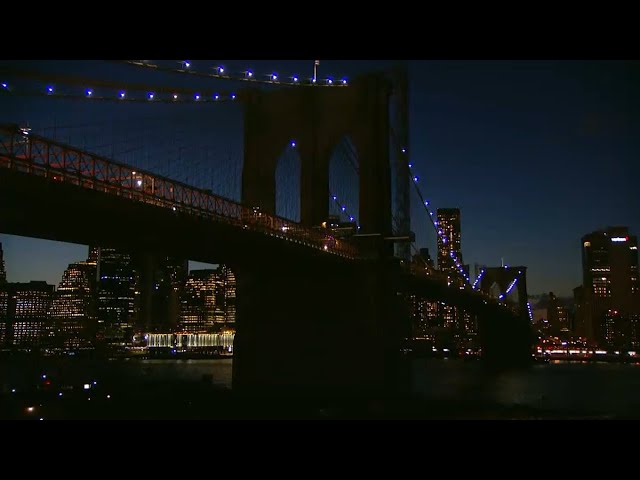|
Getting your Trinity Audio player ready...
|
Five Years After COVID-19 Devastated NYC, Victims Still Wait for a Memorial
City’s Delay in Honoring the Dead Sparks Outcry From Grieving Families and Advocates
Edited by: TJVNews.com
Five years after New York City became the global epicenter of the COVID-19 pandemic, claiming the lives of more than 46,000 New Yorkers, there remains no permanent memorial to honor the victims, the frontline workers who risked everything, or the families who continue to grieve in silence. Despite early promises, legislative proposals, and emotional appeals, efforts to commemorate the tragedy have largely stalled, as reported by The New York Post on Saturday.
Among the most notable unrealized proposals is a plan to build a COVID-19 memorial on Hart Island, the city’s Potter’s Field, where thousands of pandemic victims—many unclaimed or without means—were buried in mass graves during the peak of the crisis, according to the information provided in The New York Post report. A bill introduced in the New York City Council to explore the feasibility of such a memorial has languished for more than a year without movement.
For Jessica Alejandro, 27, whose grandfather Joseph Anthony Szalkiewicz died from COVID complications in March 2021, the city’s inaction is both painful and inexcusable. “We passed the five-year mark [last week], and to still have nothing, and to learn of this [Council] bill that has been sitting there for a year with still no movement—it really is a testament to the way that the city feels about COVID,” she told The New York Post. “Quite honestly, it is so disgusting and disheartening. I think it’s really long overdue that New York City step up the way that other cities and states across the country have.”
Jessica and her sister Danielle Alejandro, 25, have taken matters into their own hands, organizing a grassroots memorial in 2022 called the “Yellow Heart Memorial” at Queens College, where 123 yellow paper hearts were displayed in honor of students, faculty, and staff lost to the virus.
But these efforts remain isolated and symbolic, in the absence of any formal acknowledgment from the city’s leadership.
New York City is filled with monuments to past tragedies: the 9/11 Memorial, the Holocaust Museum, and countless plaques and public spaces honoring those lost to wars and disasters. But COVID-19—despite being the city’s most lethal event since the 1918 flu pandemic—has yet to receive a comparable space for remembrance.
The report in The New York Post indicated that the only official tributes thus far have been temporary or departmental, including a “COVID-19 Day of Remembrance” in March 2021, during which photos of victims were projected onto the Brooklyn Bridge for a single night.
A sculpture titled “Forever Strongest ”was unveiled by the Sanitation Department in May 2021 to honor sanitation workers lost to the virus.
Outside of these efforts, much of the burden of remembrance has fallen to private individuals and grieving families. Last week, dozens gathered in Cobble Hill, Brooklyn, in front of a makeshift memorial wall covered in photos of nursing home residents who died during the pandemic. The New York Post reported that the group, joined by eight of NYC’s mayoral candidates, marked the five-year anniversary of former Gov. Andrew Cuomo’s controversial nursing home directive, which allowed COVID-positive patients to be admitted into eldercare facilities—a policy many blame for preventable deaths.
Cuomo has denied responsibility, though criticism continues to mount.
In 2021, then-Governor Andrew Cuomo proposed the construction of a “Circle of Heroes Monument” at Rockefeller Park in Lower Manhattan, featuring maple trees and an eternal flame to honor medics and frontline workers, as per the information in The New York Post report. But the plan faced fierce opposition from Battery Park City residents, who argued the area was already saturated with solemn public memorials. The project was quietly shelved and never revisited.
Meanwhile, a broader statewide proposal to fund COVID-19 memorials across the Empire State has similarly stalled in both the Senate and Assembly committees, with no clear path forward.
Since August 2020, Manhattan Borough President Mark Levine has advocated for transforming Hart Island—long stigmatized as a mass burial site for the unclaimed—into a place of respect and remembrance, The New York Post report indicated. Levine has introduced multiple bills in the City Council to create a “COVID-19 Memorial Task Force” tasked with evaluating the site and developing proposals for a memorial. But none have advanced.
Hart Island, where drone footage during the early days of the pandemic showed workers in hazmat suits burying coffins in trenches, has become a haunting symbol of the scale and speed of the COVID crisis in NYC. The report in The New York Post said that advocates have argues that transforming the site into a memorial could offer both a dignified tribute to those buried there and a powerful space for public healing.
For families who lost loved ones—many of whom were isolated in their final days, unable to say goodbye—the lack of a public memorial feels like erasure.
“It’s as if the city has moved on and left the dead behind,” one attendee at the Cobble Hill memorial told The New York Post. “We keep their memory alive because no one else will.”
The calls for a permanent, city-sanctioned memorial are not about politics, advocates say—they are about dignity, closure, and truth.
As reported by The New York Post, the latest attempt to move the city closer to building a memorial came in March 2024, when Councilwoman Carmen De La Rosa (D-Manhattan) introduced legislation calling for a feasibility study to commemorate pandemic victims—potentially on Hart Island, the city’s public burial ground where thousands of unclaimed COVID dead were laid to rest in mass graves. However, the bill has yet to move out of the City Council’s Parks Committee, and the city’s Parks Department, which manages the island, has offered only that the measure remains “under review.”
Manhattan Borough President Mark Levine, who has championed the Hart Island memorial concept since 2020, says he’s not giving up, though he is now open to other locations. “It is important to remember and memorialize the profound loss and immense sacrifice endured by New Yorkers,” said Levine, a progressive Democrat currently running for city comptroller, in comments quoted by The New York Post.
Yet, despite years of legislative attempts—including multiple bills sponsored by Levine to establish a COVID-19 Memorial Task Force—momentum has repeatedly collapsed, with city officials citing either logistical barriers or concerns about timing.
For some, the problem isn’t lack of vision, but a lack of political will. John Beckmann, a Manhattan-based architect, proposed a sweeping 2021 concept that would install twelve towers of light on Hart Island, visible from across the boroughs, to be illuminated on a designated remembrance day each year, The New York Post report said. The proposal, Beckmann explained, was designed to capture both grief and collective healing, while avoiding the commercial tone of a typical tourist site.
But the silence from lawmakers has grown deafening. “It’s taken a lot of time for people to recover psychologically from what we’ve all been through,” Beckmann told The New York Post. “But now is as good a time as any.”
Despite its symbolism—Hart Island was one of the most visible national images of the pandemic’s toll—not everyone believes it is a fitting location for a memorial. Access to the island is limited to ferry service, and critics argue its history as a mass grave site makes it inappropriate for a public monument.
“I don’t think it’s appropriate to turn those sacred gravesites into a tourist attraction,” Council Minority Leader Joann Ariola (R-Queens) told The New York Post. “A memorial would work better in a public park.”
This sentiment is shared by many in the public, who suggest that a more centrally located, easily accessible public space—such as Central Park, Prospect Park, or even City Hall Plaza—might better serve both mourners and tourists, while ensuring dignity and prominence.
Perhaps no voices have articulated the depth of frustration as powerfully as Jessica and Danielle Alejandro, sisters who lost their grandfather to the virus and have since become grassroots advocates for a memorial, as was noted in The New York Post report. In 2022, they organized the Yellow Heart Memorial at Queens College, displaying 123 paper hearts for each member of the campus community lost to COVID-19.
Later that year, the sisters sent a letter to Mayor Eric Adams, imploring him to initiate a permanent city-funded monument. The reply? That such a move was “premature.”
Undeterred, the Alejandros approached State Senator Jamaal Bailey (D-Bronx/Westchester), who introduced legislation to establish a permanent funding mechanism for pandemic-related memorials across New York State. The New York Post report said that that bill, too, has since stalled in committee, echoing the broader inertia seen at both the city and state levels.
The lack of progress stands in stark contrast to other cities and states that have moved forward with plans or completed installations to honor pandemic victims. From small towns to national memorial gardens, dozens of municipalities have created spaces for mourning and reflection—while New York City, the hardest hit, still has only a temporary mural, a sanitation department sculpture, and a single night of images projected on the Brooklyn Bridge to show for the collective trauma endured.
And as noted in The New York Post report, even former Governor Andrew Cuomo’s 2021 proposal to build a “Circle of Heroes” memorial at Rockefeller Park was scrapped after local residents raised objections over adding yet another monument to the crowded Battery Park landscape.
With the fifth anniversary of New York’s first wave now behind us, and thousands still living with the grief of unacknowledged loss, advocates argue that the city can no longer afford to delay.
“We’re not just mourning individuals,” one healthcare worker told The New York Post. “We’re mourning a generation lost, the moral injury to those on the frontlines, and the collective trauma of a city that stood on the brink and held the line.”




